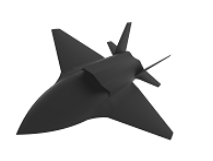Projeto de aeronave de combate não tripulada de quinta geração para apoio aéreo próximo
DOI:
https://doi.org/10.18667/cienciaypoderaereo.693Palavras-chave:
aeronave não tripulada, apoio aéreo aproximado, furtividade; militarResumo
A evolução na concepção de aeronaves de combate foi modificada pela inclusão de novos parâmetros de alta exigência, incluindo as áreas de investigação relacionadas com a aerodinâmica, a furtividade e a otimização dos processos operacionais. O presente artigo contempla o desenho de um Veículo de Combate Aéreo Não Tripulado (UCAV) para a execução de missões de Apoio Aéreo Próximo (CAS) nas próximas décadas. Os resultados obtidos demonstram as capacidades dos UCAV como aeronaves de quinta geração para a substituição de frotas reconhecidas a nível mundial (A-10 Thunderbolt II e Sukhoi Su-25) e, além disso, garante sua utilidade e viabilidade nos futuros ambientes de combate. Da mesma forma, a pesquisa se concentra em uma das variáveis de maior discussão a respeito da sobrevivência no combate aéreo, trata-se da furtividade por fenômenos eletromagnéticos, com a qual se obtiveram valores de Seção Equivalente de Radar (RCS) iguais a -24,18 dBsm ou representáveis numa área de detectabilidade de 0,0038 m2 em configuração limpa, de modo que este valor é inferior ao de aeronaves furtivas como é o Northrop Grumman B-2 Spirit. Finalmente, o projeto permite a operação com peso de descolagem máximo de 61,900 lb e uma carga paga de 11,240 lb que sejam condicionados a uma configuração alar e de estabilizadores para escalas transônicas.
Downloads
Referências
Atique, M. S. A., Barman, S., Nafi, A. S., Bellah, M., & Salam, M. A. (2016, 12 de julio). Design of a fifth generation air superiority fighter. AIP Conference Proceedings, 1754. https://doi.org/10.1063/1.4958444
Airforce Magazine. (2019). B-2 at 30: Improving with Age. https://www.airforcemag.com/PDF/MagazineArchive/Magazine%20Documents/2019/July%202019/0719_B-2%20for%20DR.pdf
Au, T. A., Hoek, P. J., & Lo, E. H. S. (2018). Combat Analysis of Joint Force Options using Agent-Based Simulation. 2018 Military Communications and Information Systems Conference (MilCIS), 1-7. https://doi.org/10.1109/milcis.2018.8574114
Biswas, K. (2020). Military Aviation Principles. Military Engineering, 1. https://doi.org/10.5772/intechopen.87087
Bravo-Mosquera, P. D., Cerón-Muñoz, H. D., Díaz-Vázquez, G., & Martini Catalano, F. (2018). Conceptual design and CFD analysis of a new prototype of agricultural aircraft. Aerospace Science and Technology, 80, 156-176. https://doi.org/10.1016/j.ast.2018.07.014
Chairman of the Joint Chiefs of Staff (CJCS). (2014). Close Air Support (Joint Publication 3-09.3 ed.). Defense Department Intelligence and Security. https://fas.org/irp/doddir/dod/jp3_09_3.pdf
Chatzigeorgiadis, F. & NAVAL POSTGRADUATE SCHOOL MONTEREY CA. (2004). Development of Code for a Physical Optics Radar Cross Section Prediction and Analysis Application. Van Duuren Media.
Chen, S., Yue, K., Hu, B., & Guo, R. (2015). Numerical Simulation on the Radar Cross Section of Variable-Sweep Wing Aircraft. Journal of Aerospace Technology and Management, 7(2), 170-178. https://dx.doi.org/10.5028/jatm.v7i2.416
Chen, W. (2004). The Electrical Engineering Handbook. ELSEVIER Academic Press.
Cidrás-Estévez, J. (2019). Herramienta Informática para el Diseño Conceptual de Aeronaves de Tipo Subsónica y Estudio de las Actuaciones. Universidad de Cádiz. https://rodin.uca.es/xmlui/handle/10498/22567?locale-attribute=es
Correll, J. (2019, 5 diciembre). The Ups and Downs of Close Air Support. Air Force Magazine. https://www.airforcemag.com/article/the-ups-and-downs-of-close-air-support/
Cummings, R. M., Liersch, C. M., Schütte, A., & Huber, K. C. (1994). Two-equation eddy-viscosity turbulence models for engineering applications. AIAA Journal, 32(8), 1598-1605. https://doi.org/10.2514/3.12149
Deskin, W., & Yankel, J. (2002). Development of the F-22 Propulsion System. 38th AIAA/ASME/SAE/ASEE Joint Propulsion Conference & Exhibit, 1-10. https://doi.org/10.2514/6.2002-3624
Sathyamoorthy , D. (2015). A Review of Security Threats of Unmanned Aerial Vehicles and Mitigation Steps. The Journal of Defence and Security, 6(1), 81-97. https://www.researchgate.net/publication/282443666_A_Review_of_Security_Threats_of_Unmanned_Aerial_Vehicles_ and_Mitigation_Steps
Dirwan, A. (2020). The Analysis of Fighter Aircraft Require- ment and Pilot Training for Indonesia’s Air Area Security. International Journal of Solid State Technology, 63(3), 1.631-1.632. http://eprints.universitassuryadarma.ac.id/478/1/9_Dirwan.EPrint.pdf
Fields, N. R. (2012). Advantages and challenges of unmanned aerial vehicle autonomy in the Postheroic age [Tesis doctoral. James Madison University]. https://commons.lib.jmu.edu/master201019/205/
Green, J., & Zeckhauser, R. (2019). Thunder Versus Lightning: A Performance and Cost Analysis of the A-10 “Warthog” Versus the F-35 Joint Strike Fighter. Journal of Benefit-Cost Analysis, 10(3), 434-468. https://doi.org/10.1017/bca.2019.27
Ho, O. (2018). Future Air Force Close Air Support Aircraft. The Faculty of the Department of Aerospace Engineering San José State University. https://apps.dtic.mil/sti/pdfs/AD1104495.pdf
Jenn, D. (2019). Radar and laser cross section engineering (3th ed). AIAA Education Series.
James, D. L., & Gouré, D. (2019). The Implications of Fifth-Generation Aircraft for Transatlantic Airpower A Primer. Atlantic Council. https://www.atlanticcouncil.org/wp-content/uploads/2019/10/FINAL-Air-Power-Domain-Report-WEB-1.pdf
Kong, W., Zhou, D., Yang, Z., Zhang, K., & Zeng, L. (2020). Maneuver Strategy Generation of UCAV for within Visual Range Air Combat Based on Multi-Agent Reinforcement Learning and Target Position Prediction. Applied Sciences, 10(15), 5198. https://doi.org/10.3390/app10155198
Liangliang, C., Kuizhi, Y., Weigang, G., & Dazhao, Y. (2016). Integration analysis of conceptual design and stealth-aerodynamic characteristics of combat aircraft. Journal of Aerospace Technology and Management, 8(1), 40-48. https://doi.org/10.5028/jatm.v8i1.514
Lockheed Martin Corporation. (2021). F-22 Raptor Digital, Dominant, Ready. Lockheed Martin Corporation. https://www.lockheedmartin.com/en-us/products/f-22.html
Nordhagen, L. C. (2018). A-10 Adaptive Basing Operations and Applications in Support of SOF. Naval Postgraduate School. https://apps.dtic.mil/sti/citations/AD1069675
Northrop Grumman. (2021). A-10 Thunderbolt II Specifications. Northrop Grumman. https://www.northropgrumman.com/what-we-do/air/a10-thunderbolt/
Rani, C., Modares, H., Sriram, R., Mikulski, D., & Lewis, F. L. (2016). Security of unmanned aerial vehicle systems against cyber-physical attacks. Journal of Defense Modeling and Simulation, 13(3), 331-342. https://doi.org/10.1177/1548512915617252
Raymer, D. P. (2018). Aircraft Design: A Conceptual Approach (Sixth Edition). American Institute of Aeronautics and Astronautics (aiaa).
Sepúlveda-Palacios, E., & Smith, H. (2019a). Conceptual design of a fifth generation unmanned strike fighter. AIAA Sci- tech 2019 Forum. https://doi.org/10.2514/6.2019-0811
Sepúlveda-Palacios, E., & Smith, H. (2019b). Impact of mission requirements on the design of low observable ucav configurations. Aircraft Engineering and Aerospace Technology, 91(10), 1295-1307. https://doi.org/10.1108/AEAT09-2018-0249
Touzopoulos, P., Boviatsis, D., & Zikidis, K. C. (2018). Constructing a 3D model of a complex object from 2D images, for the purpose of estimating its Radar Cross Section (rcs). Journal of Computations & Modelling, 1(1), 15-28.
Watts, B. D. (2013). The Evolution of Precision Strike. Center for Strategic and Budgetary Assessments. https://csbaonline.org/uploads/documents/Evolution-of-Precision-Strike-final-v15.pdf
Yaacoub, J.-P., Noura, H., Salman, O., & Chehab, A. (2020). Security analysis of drones systems: Attacks, limitations, and recommendations. Internet of Things, 11, 100218. https://doi.org/10.1016/j.iot.2020.100218

Downloads
Publicado
Edição
Seção
Licença
Declaração de cessão de direitos autorais à revista
O autor cede exclusivamente à Revista os direitos de exploração (reprodução, distribuição, comunicação pública e transformação) para explorar e comercializar a obra, no todo ou em parte, em todos os formatos e modalidades de exploração presentes ou futuros, em todas as línguas, por todo o período de vida da obra e pelo mundo inteiro.
Todo o conteúdo publicado na revista científica Ciencia y Poder Aéreo está sujeito à licença de reconhecimento internacional Creative Commons 4.0, cujo texto completo pode ser encontrado em http://creativecommons.org/licenses/by/4.0/
A licença permite que qualquer usuário baixe, imprima, extraia, arquive, distribua e comunique publicamente este artigo, desde que seja dado o devido crédito aos autores: ao(s) autor(es) do texto e a Ciencia y Poder Aéreo, Revista da Escola de Pós-Graduação da Força Aérea Colombiana. Exceto quando for indicado o contrário, o conteúdo deste site será licenciado sob uma licença Creative Commons Attribution 4.0 Internacional.
Para usos de conteúdo não previstos nestas normas de publicação é necessário entrar em contato diretamente com o diretor ou editor da revista através do e-mail cienciaypoderaereo1@gmail.com
A Escola de Pós-Graduação da Força Aérea Colombiana e esta revista não são responsáveis pelos conceitos expressos nos artigos, nem pelos metadados fornecidos ou pelas afiliações que os autores declarem, sendo assim de inteira responsabilidade dos autores.

Licença Creative Commons
Os autores concedem à revista os direitos de exploração (reprodução, distribuição, comunicação pública e transformação) para explorar e comercializar a obra, inteira ou parcialmente, em todos os formatos e modalidades de exploração presentes ou futuras, em todas as línguas, por todo o período de vida da obra e no mundo inteiro.
Todos os conteúdos publicados na revista científica Ciencia y Poder Aéreo estão sujeitos à licença de reconhecimento 4.0 4.0 Internacional de Creative Commons, cujo texto completo pode-se consultar em http://creativecommons.org/licenses/by/4.0/
A licença permite a qualquer usuário baixar, imprimir, extrair, arquivar, distribuir e comunicar publicamente um artigo, desde que seja dado crédito aos autores do trabalho: aos autores do texto e a Ciencia y Poder Aéreo, Revista Científica da Escola de Pós-Graduação da Força Aérea Colombiana. Salvo onde for indicado o contrário, o conteúdo deste site é licenciado sob uma licença Creative Commons Atribución 4.0 internacional.
Para usos de conteúdo não previstos nestas normas de publicação é necessário entrar em contato diretamente com o diretor ou editor da revista através do e-mail cienciaypoderaereo1@gmail.com
A Escola de Pós-Graduação da Força Aérea Colombiana e esta revista não são responsáveis pelos conceitos expressos nos artigos, nem pelos metadados fornecidos ou pelas afiliações que os autores declarem, sendo assim de inteira responsabilidade dos autores.




















